In our spoiler-free review, we tell you why God of War Ragnarok is one of the best games of the year without giving it away. A contradiction? Only at first glance.
What we missed that feeling! That feeling of putting aside the wet sweaty controller with equal measure of emotion and pride, looking at the credits almost in disbelief, barely able to put into words what we just experienced.
“Video game” doesn’t quite cover it, “fucking awesome masterpiece” does. It’s that indescribable feeling why we fell in love with video games at some point. This experience that many trailers promise us like prophecies. This treasure that we chase endlessly and that we want to capture at least once a year. And no matter what you want to call it now – feeling, experience or treasure – we’ll say it honestly and clearly for once: We haven’t had THAT in ages.

What does “spoiler-free” mean?
God of War: Ragnarok is one of those games where spoilers can actually spoil your fun. In order to justify our rating, we will only describe story details and events in this review that were either shown in the official trailers or already happen in the first two hours of gameplay.
Since the game is a direct sequel, we cannot avoid going into the events of the predecessor. If you have skipped it so far and want to catch up, you should therefore read this review afterwards.
On the one hand, it’s because top-class studios like Rockstar Games, Naughty Dog and co. have raised the bar for groundbreaking games higher and higher in recent years. On the other hand, it is also logically related to the current games market.
Dozens of postponements, some disappointments, more remakes than innovations – 2022 is quite a drought in gaming terms. Even the few exceptions like Elden Ring or Stray feel more like cold comfort because they painfully remind us that such experiences are currently so rare. Yep, melodrama we can do.
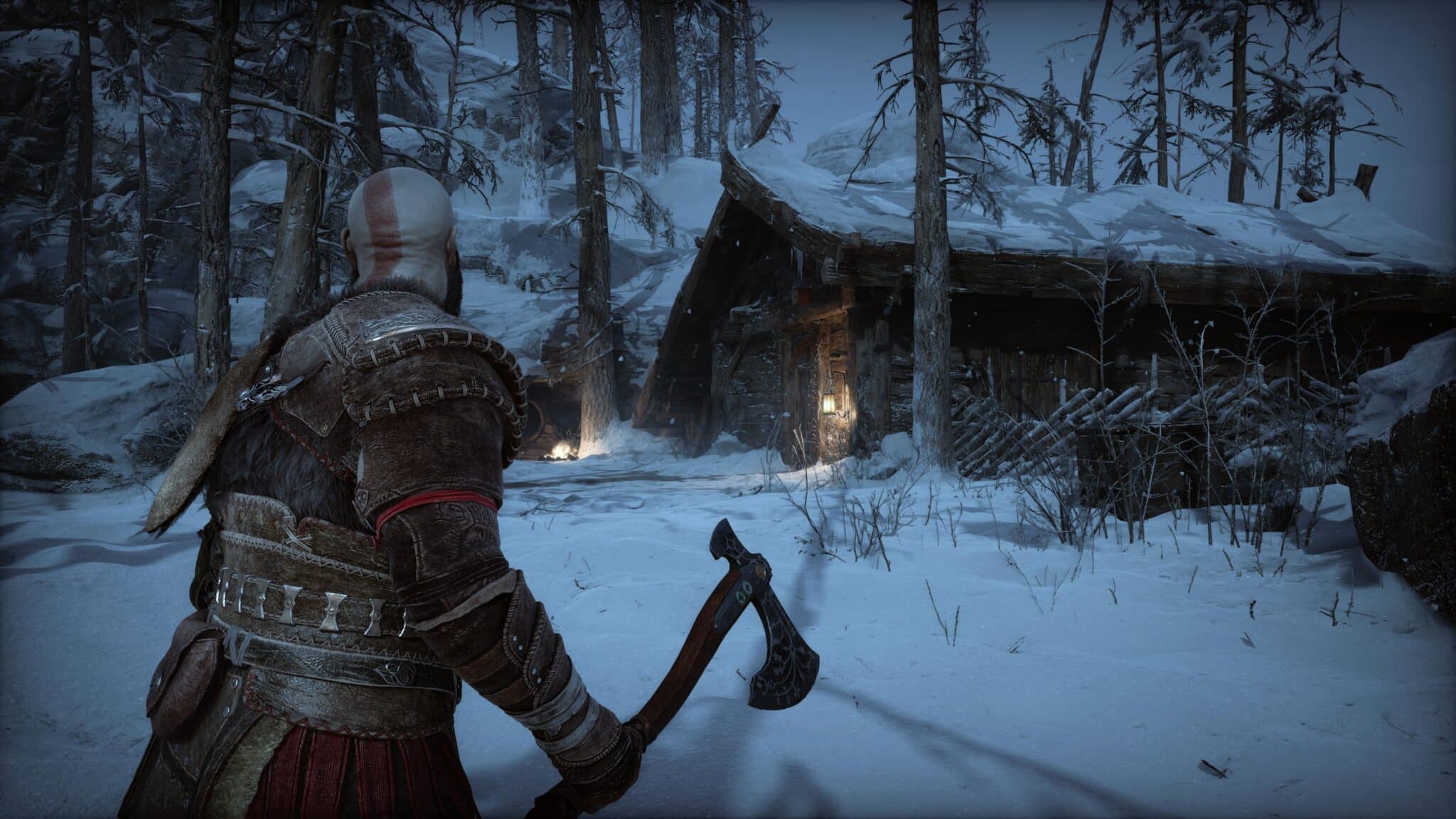
If it weren’t such a luxury issue, one might rightly shout, stomp and kick anything made of plastic! But the year isn’t over yet and there’s still God of War Ragnarok. And we think to ourselves: Please be good, please, at least you, you just have to be good! Please don’t be a 1-to-1 copy! Be an honourable sequel, more than that, be a successful conclusion! At least half as epic as Marvel’s Avengers: Endgame!
And here it is: Kratos sits in a cave while the Fimbulwinter rages outside. Tired and afraid because he knows the Norse gods will come to avenge those he was forced to kill on his last journey. But this is only the beginning of something much bigger: a war between all the gods, the so-called Ragnarok.
Since the inevitable can happen at any time, he prepares his son Atreus for everything. Train him to be a warrior. Stay at home with him, under the dome of a protective spell. The two are now a strong team, even if they keep dangerous secrets from each other.
The first two hours of God of War: Ragnarok offer everything with which Part 1 could already shine: Norse worlds. Massive third-person battles. Emotional conversations with excellent voice actors, both in English and German. All this staged as a one-shot without visible cuts and loading pauses.
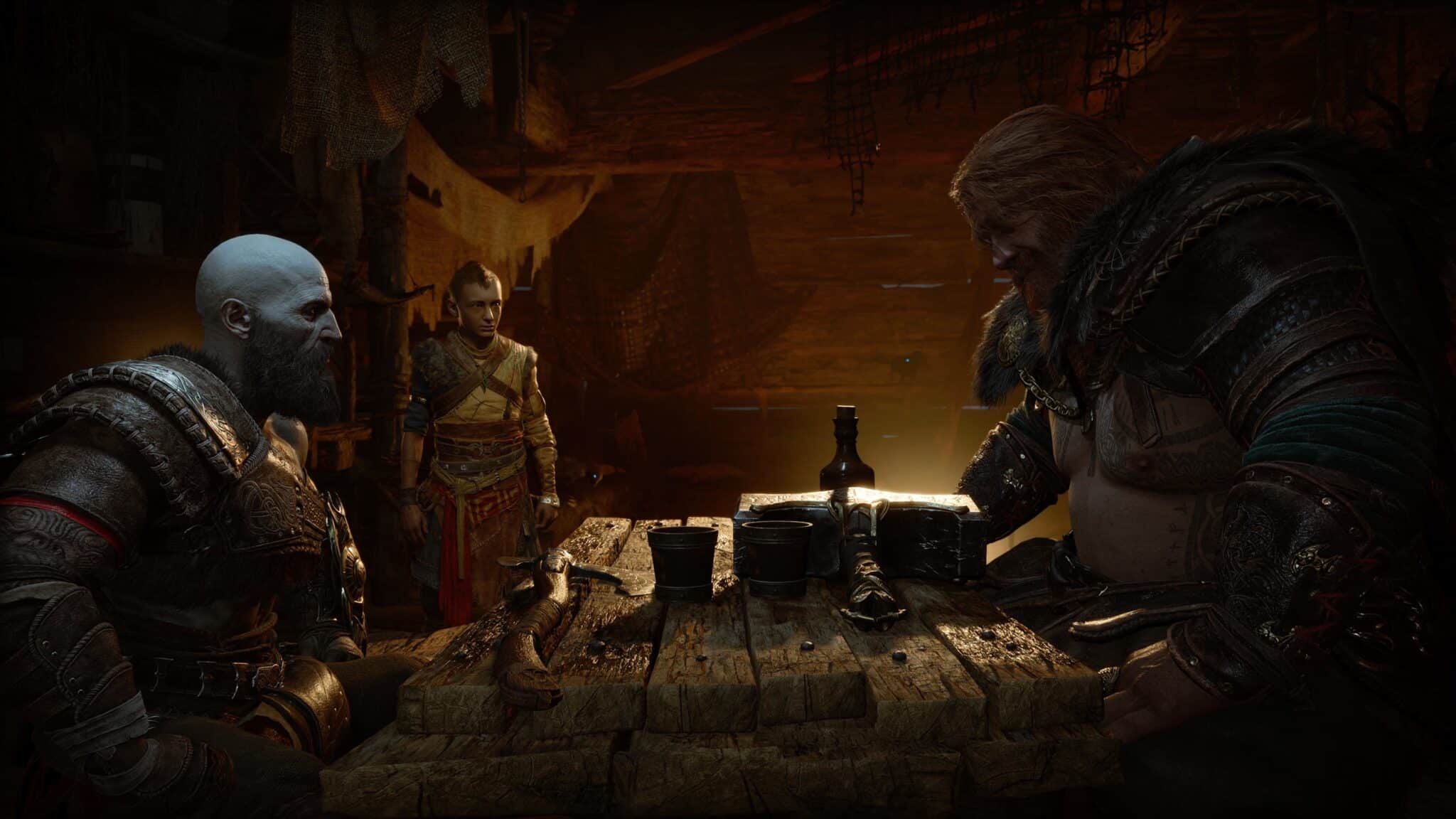
So everything as in the predecessor, everything on the very highest production quality … and all somehow a bit disappointing. That’s it already? More of the same? What’s new now, please? At least that’s what we think until Thor and Odin come knocking on the door. It’s not a courtesy call, but a last-ditch attempt to prevent a gigantic ruckus. In vain.
“Don’t hold back, I want to see the god of war!” shouts Thor, that mumbling, obnoxious dream of a villain, who after only ten minutes makes us incredibly want to see an all-smashing final battle. But we agree with him wholeheartedly, we too want to see the God of War, especially the new one! That which justifies the purchase price of 80 euros! That which triggers the sweat on the controller!
Come on, part 1 was an epic weekend trip to the giant mountains, but we’re ready for more now. GIVE US ALL! And there’s a brief flash of it. A little taste of great entertainment. The duel between Olympus and Asgard – the soundtrack captures the first battle of the two war gods in cinematic style. Under their lightning bolts and blows, Midgard is destroyed with great visual power. Then silence reigns again and the adventure begins. “Wow doesn’t hit it, not even close.
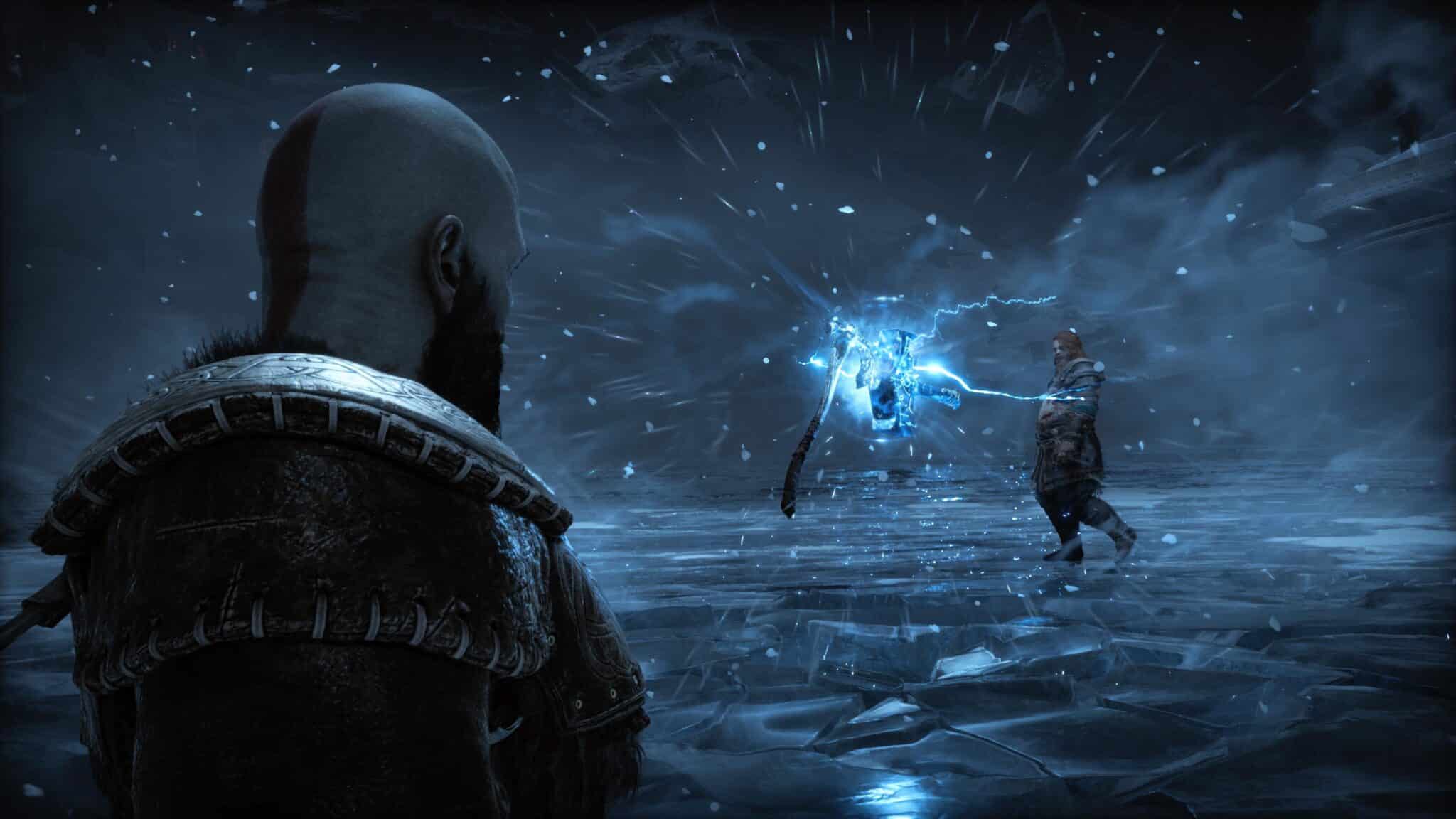
So, the keyboard should now be glowing just like Kratos’ weapons. Since we want to save the rhetoric bombast for the ABSOLUTELY GENIAL of God of War Ragnarok (without spoiling!), we’re going to dial it down a bit now and return to a classic test.
An upgrade on all levels
To prevent Ragnarok and learn how to control their own destiny, Kratos and Atreus go into hiding with their dwarven friends Sindri and Brokk. From now on, their house in the interworlds serves as a practical base, including a forge and a place to sleep.
From here they set out through the mystical gates to ever new adventures in the Nordic worlds. The typical sequence of events – exploring, solving puzzles, fighting – is clearly oriented towards its predecessor, but the new wind of God of War Ragnarok is increasingly noticeable on all levels the further we progress in the game.
Why we’re testing a PlayStation game
At first glance, it may surprise some of you that we are publishing an extensive review of God of War Ragnarok. We decided to do so for the following reasons:
- According to a recent survey 33% of our community already own a PS4 or PS5, so they are facing the question right now if God of War Ragnarok is the right game for them. That’s the question we want to answer.
- The predecessor God of War was released for the PC this year, so it’s only a matter of time before the sequel is officially announced. For most of you, however, it is interesting to see how good this game is now, not in two or three years. Of course, we will also take a close look at a possible PC adaptation.
- We generally see that the platforms are growing closer together through cloud gaming and subscription services. You can play Halo Infinite with the same score on the PC just as you can on the console or even on your mobile phone. We as editors have to take this development into account if we want to remain the best and most important source of information for your favourite hobby.
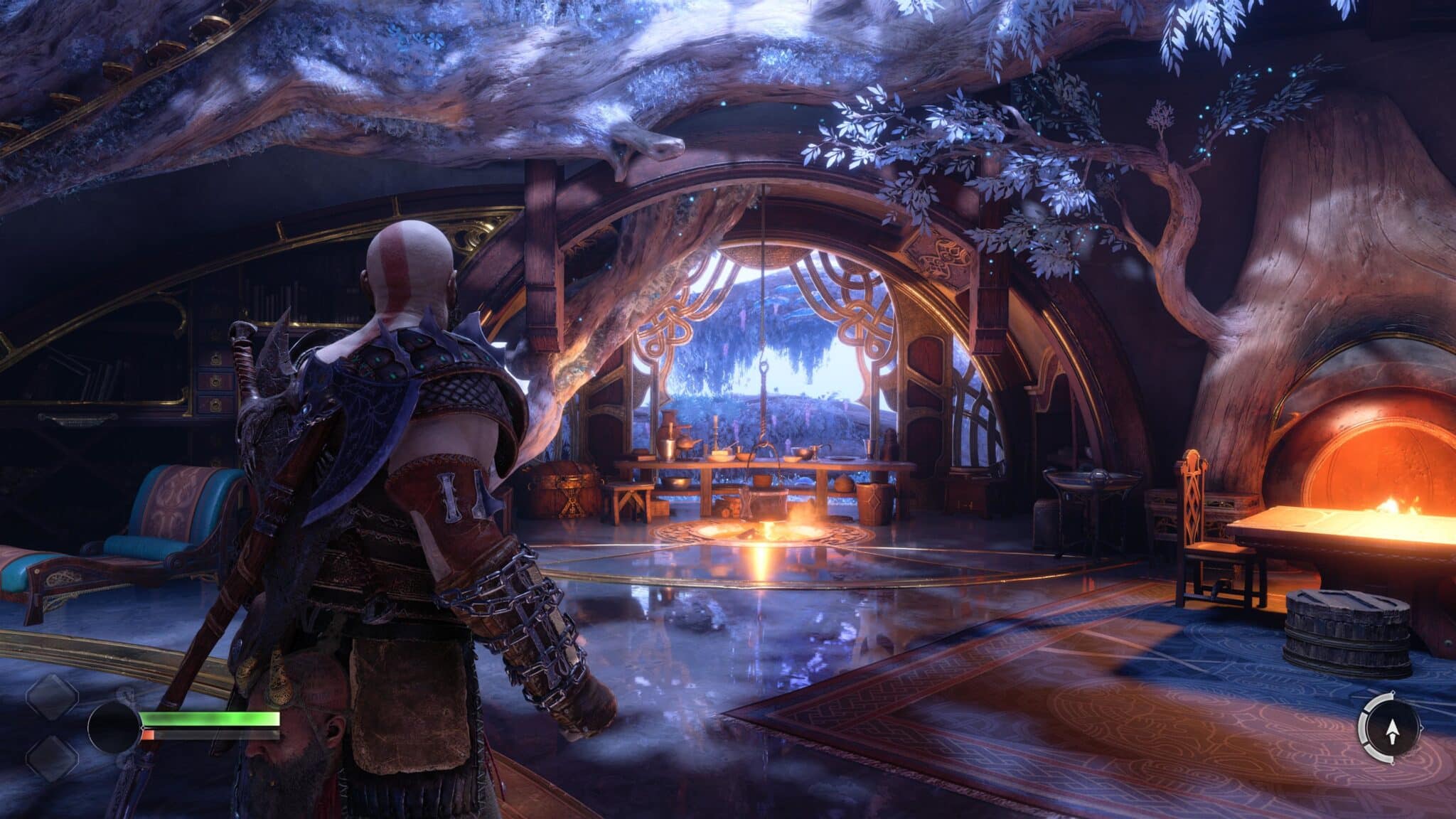
The worlds are more beautiful and reward excursions even more
The shift from the classic God of War trilogy to 2018’s God of War was a graphical dimensional leap. This leap remains absent in Ragnarok, as both the basic technical framework and the scenario remain basically the same.
“In principle”, because the team at Sony Santa Monica Studios not only makes the most of its in-house graphics technology, but also stages its worlds in a much more varied and impressive way than in the predecessor. The summery river country of Svartalfheim. The crystal palaces of Alfheim. The fantasy jungle of Vanaheim.
Optically, this is great and boastful screenshot cinema, especially in the level of detail and the wide view. “Pah, graphic blender!” Not by a long shot, because the graphical enhancement is also accompanied by a playful one. While Cyberpunk 2077, Assassin’s Creed Valhalla and Horizon: Forbidden West rely on large open worlds, Ragnarok continues to forgo them and sticks to its small, staked-out areas
For the development team, the motivation and reward of a journey is always noticeably and visibly more important than the number of places you can travel to. This is already evident in the normal Loot-to-Go, whose chests we repeatedly chase after like bloodhounds because they are hidden behind quickly solvable but nevertheless smart puzzles.
But the new highlight awaits us in the side quests. While in the predecessor these were still small and ignorable excursions, the quests are now not only linked to real stories, but also lead to completely new, optional areas.
In Svartalfheim, for example, we learn more about the dark past of a companion. And what at first sounds like a dull checkpoint run-through quickly turns out to be a mixture of puzzles, climbing and combat passages that is as varied as it is challenging to play, while we learn one secret after another. Nothing that is in any way important for the main story. But something that brings us much closer to our companion.
Also when it comes to rewards, God of War Ragnarok always goes the extra mile. Weapons and armour don’t just lie around, but always tell a fitting story. Keys don’t open up simple treasure chests, but doors and gates to much bigger surprises. We cannot reveal more than that. And we don’t want to reveal any more.
Because it’s all so clever, so rewarding, so non-irrelevant and main-quest-equivalent that every time we think to ourselves, “Thank goodness we did that, thank goodness we didn’t miss that. “
The puzzles are more creative and smart
As cool and useful as Kratos’ recallable leviathan axe was established in the first part, almost every puzzle at some point involved freezing a wheel in a mechanism with a well-aimed throw to open or hold open a gate. As a change of pace from combat this was quite nice, but at some point it felt like an unnecessary block.
Again, thankfully, God of Ragnarök makes a big leap forward that really impressed us. Freezing wheels is elementary school class after all, as new puzzle masters we have to solve the most varied of head-scratchers, from small physics gimmicks to gigantic cog-wheel contraptions.
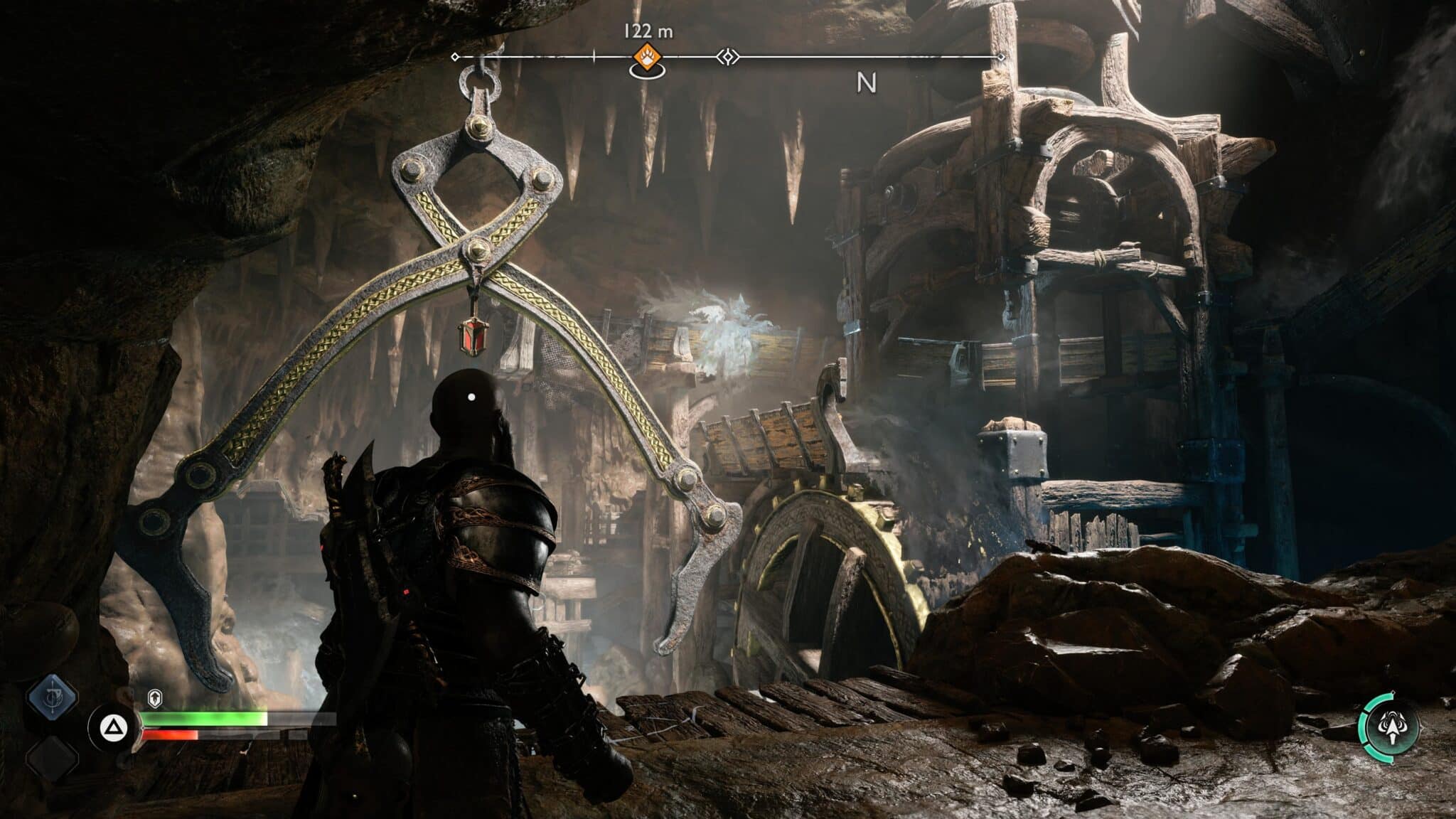
And then each area also adds new mechanics and tools that allow for ever more creative problems and solutions and, like a good Metroidvania, invite us to experiment with our abilities and return to regions we’ve already explored!
It’s always a cool challenge that turns out to be fiddly enough that we feel mighty smart after solving the puzzles. But also short and clear enough that it never degenerates into tedious trial and error.
The battles finally deliver an all-time challenge
All right, the previous has been delicious, but let’s finally get to the main course and answer the most important question of all: How fucking good does it feel to split dozens of monster skulls with the weapons of a god of war?
The brilliance of God of War was based on the fact that not only did the battles look great, not only did they play great, but they always remained tactical and interesting as a matter of principle.
Principally, because the first part, despite all its greatness, left two wishes unfulfilled: more enemy types and more difficult opponents. Because, if we’re honest, it wasn’t until we fought the optional Valkyrie bosses that we understood and appreciated the combat system at all.
We were also able to defeat all the normal enemy hordes by purely hammering them in and, at least on the normal difficulty level, were almost never forced to make our trainer from Sparta proud. Thank you, Santa Monica Studios, for saying for Ragnarok: You want to get punched in the face? Then you’ll get punched in the face!
It seems like an homage to the older hack’n’slay games: Because fighting is now more frequent, longer and harder on four different levels: On level 1, the normal hordes of enemies await us, but now they go into battle with much more variance, with archers in the background, with berserkers in the foreground and sometimes there is a lizard in between that also wants to annoy.
An especially cool and dangerous new feature: Enemy attacks with Bifrost spells do potential extra damage, which is added on another hit!
On level 2, the word “intermediate boss” is then redefined, as both mini-bosses and mini-end bosses gather here. While the fight against a Dreki turns out to be comparatively harmless, the fight against Alva, the albatross guardian, is much more demanding.
Level 3 is finally reserved for the real final bosses, which remain particularly memorable with their toughness and staging. And level 4? Well, those are the many hidden optional and really tough bosses, for which we regularly needed several attempts. Burn in hell, but thanks for the fight!
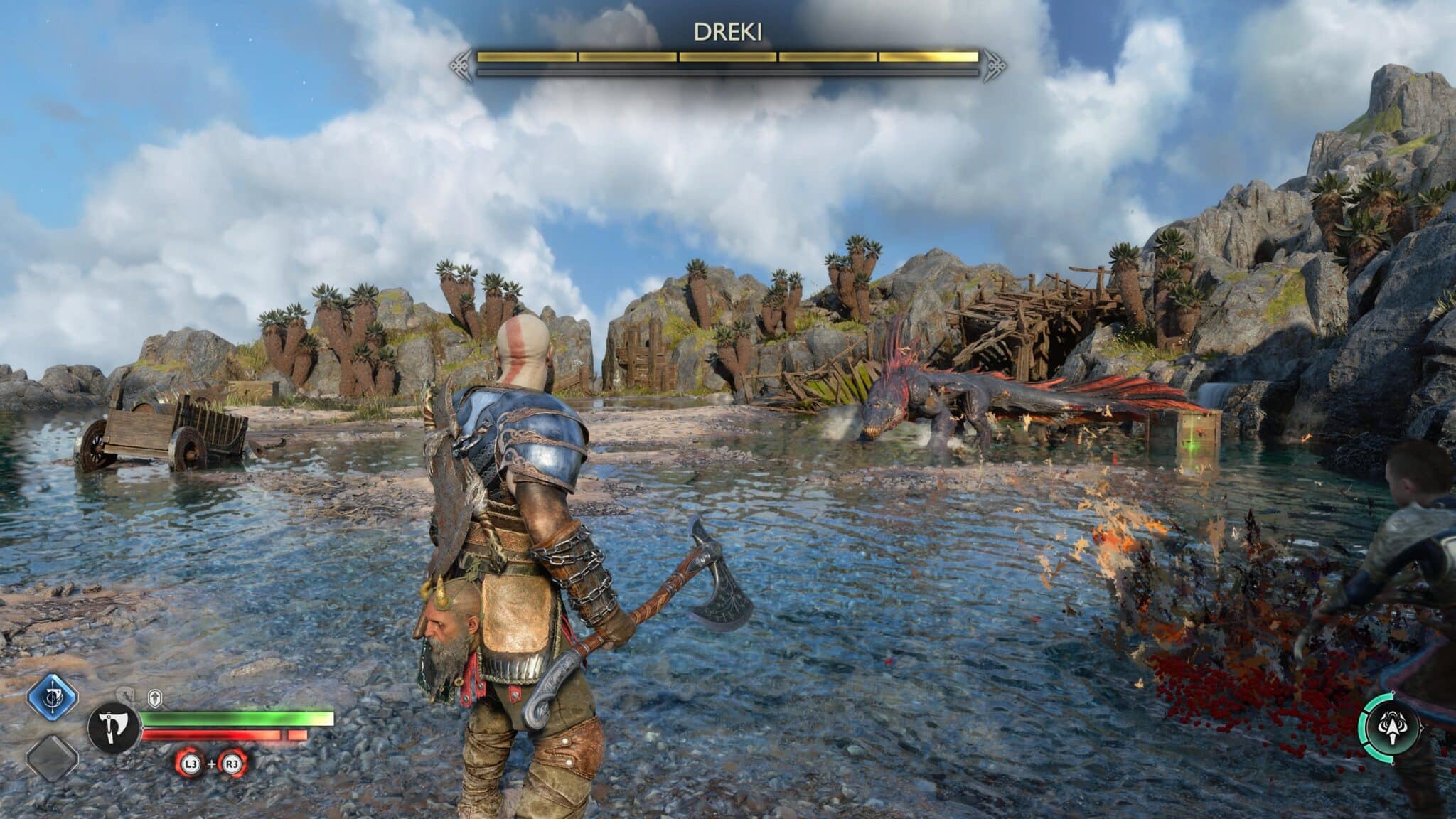
Kratos and we never stop learning!
Since we were allowed to keep the axe and chaos blades from part 1, we start this time with a comparatively large fighting repertoire. Deal with individual enemies with the axe, hit entire groups with the blades, deal effect damage, counterattack, block with the shield, dodge, go into rage mode and once unleash the complete fury in mega blows – it still feels epic even after twenty hours.
Especially since we can unlock new attacks in the skill tree with our experience points, which we can then intuitively include in our fighting style. The shield skill tree from part 1 had to give way, the new system says instead: It doesn’t get more offensive than this!
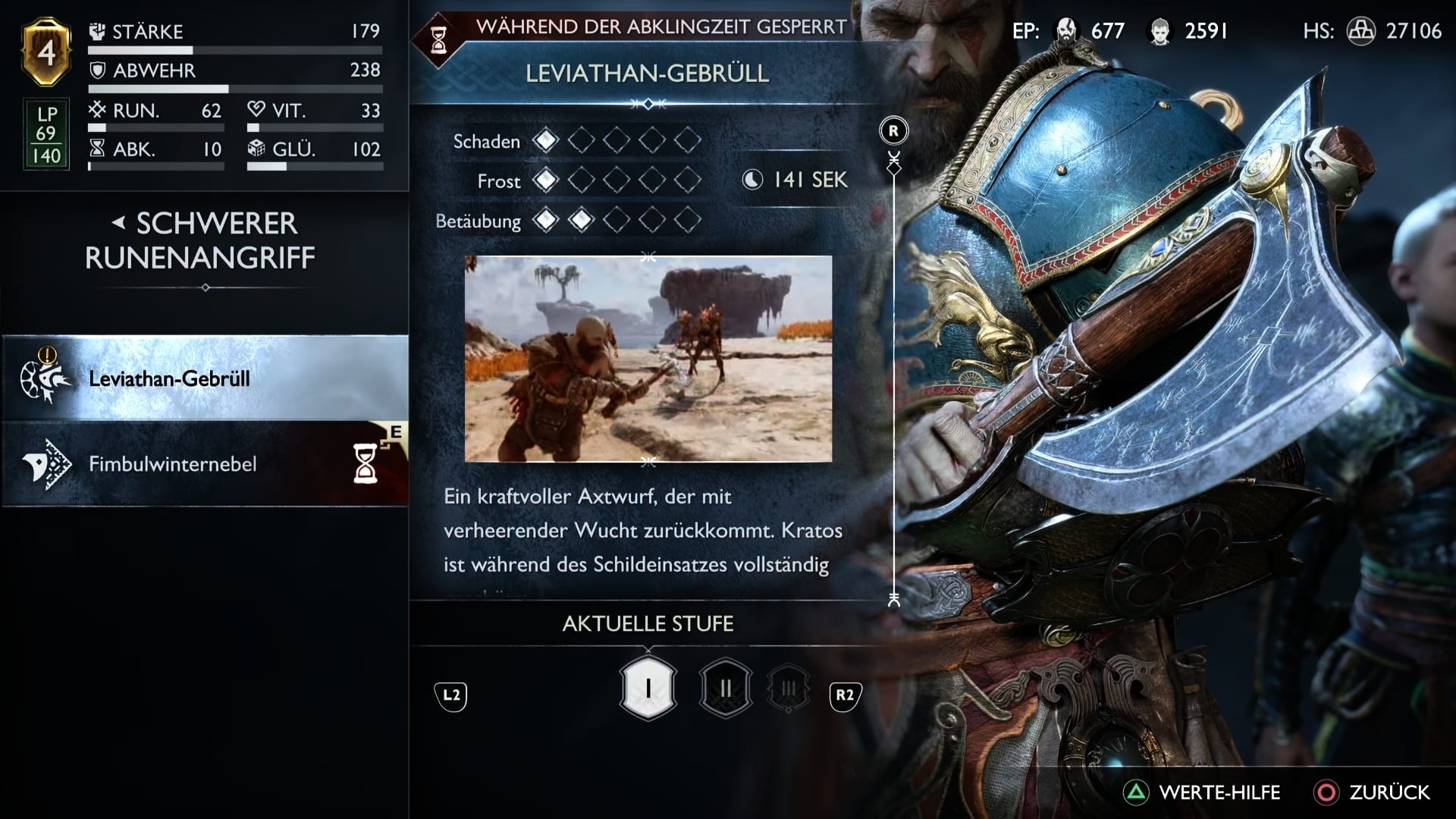
Praise also goes to the enhanced companion system, which does an exemplary job of helping us flail enemies. The spice that tops it all ultimately comes from the fact that completely new manoeuvres are also unlocked in the course of the story, which provide even more combination possibilities.
The story, possibilities and difficulty level always go hand in hand: Never did we have the feeling that it was too easy or too hard. Even though God of War Ragnarok allows saving at really every moment (!), we got through the game optimally with the automatic and fairly set save points without it mutating into a boring walk. By the way: If you want, you can adjust various options and aids in the settings for an individual difficulty level.
The RPG-Lite that is no longer quite so lite
As in the predecessor, Kratos and Atreus can invest all the materials they collect into pretty equipment at the Dwarven Forges. Here, however, Ragnarök has overdone things a bit for our taste: Chest armour and weapon enhancement, this part is still fine, but when three to four more armour levels are added, the damage system behind the fights becomes confusing and unnecessarily mathematical.
The special weapon attacks are still easy to find and directly applicable, but spells, amulets, relics & Co. require reading, fiddling around and collecting. If, in the end, they only grant minor bonuses in battle, while the main damage clearly remains with the weapons, the question arises whether it is really worth bothering with them at all. Ragnarök is obviously aware of this, as it offers an equipment automatic.
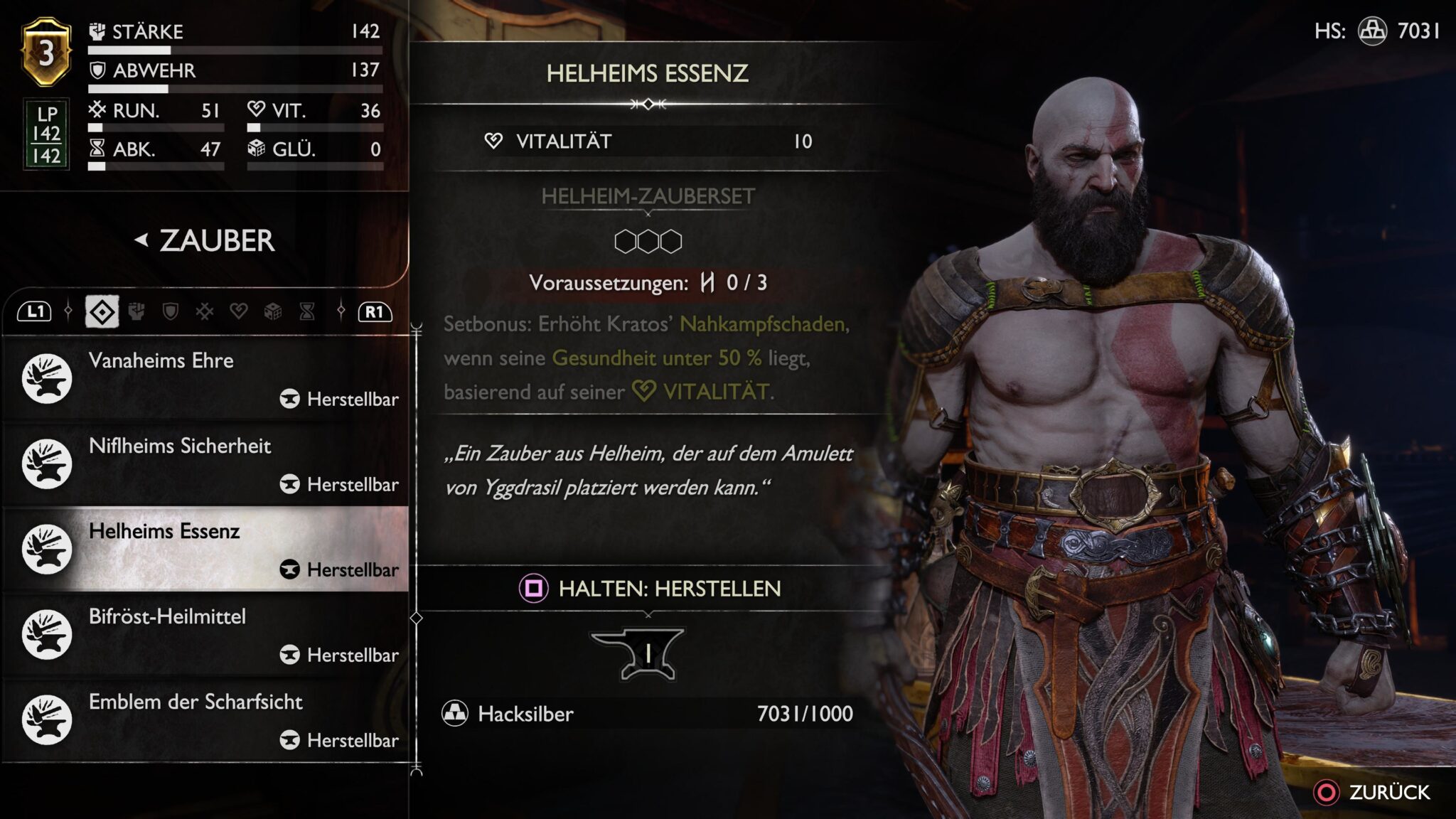
This is not a huge problem now, because it is of course fun to collect, craft and equip better and better equipment. And on the higher difficulty levels it makes a difference whether the frost damage of your axe increases by 5 or 10 percent. The otherwise great flow of the game is, in our opinion, somewhat slowed down by the regular menu and item fiddling.
Without spoiling: The ABSOLUTELY GENIAL
This is the spoiler limit. We can’t and won’t talk about what lies beyond it, for good reason, because you definitely want to have, enjoy and suffer “that experience” for yourselves. What we can do, however, is describe the feeling of the game. Quite simply, what you see is what you get to play.
Over time, the game introduces new surprises and premises that will keep changing your view of the story and the gameplay – and your expectations of both. It’s about amazing places you’ll travel to that you didn’t expect.
It’s about fascinating friends and enemies you’ll meet that you didn’t expect. And it’s about deeds you’ll do that you didn’t expect.

God of War Ragnarok doesn’t just want to tell a story, it wants you to really take your place in that story and see it from all angles. This isn’t a typical black versus white video game duel like we’ve seen hundreds of times before. Here, both good and evil are gods, but somehow they are also human.
People who don’t know what fate has in store for them. People with dreams and longings, with worries and fears, who hope to understand the big picture and not become the plaything of dark forces. Destiny, fate, prophecies, decisions, the war of the gods – these are mysteries from the beginning to the end of the game, which may not all be clarified, but which determine everything.
This atmosphere of waging war not only between emotional humans but also between overpowering gods is a thunderstorm whose end and resolution one awaits as joyfully as fearfully. All the Norse mythology that was not used in Part 1 is thrown into the cauldron here. Even if at some point we can only keep up with all the names if we regularly consult the diligently writing journal.
A worthy end
But let it be all right with us if it pays in and leads to such an epic finale as in this game. Let the North burn, let’s cheer, let’s cry, let’s scream and finally get it over with. And gamble another fucking awesome video game.
To be the God of War for real, to gain more and more strength, to challenge whoever, to strike down whoever – no, Kratos isn’t retired, his hot time isn’t over already, it’s just starting now, when his family is on the line.
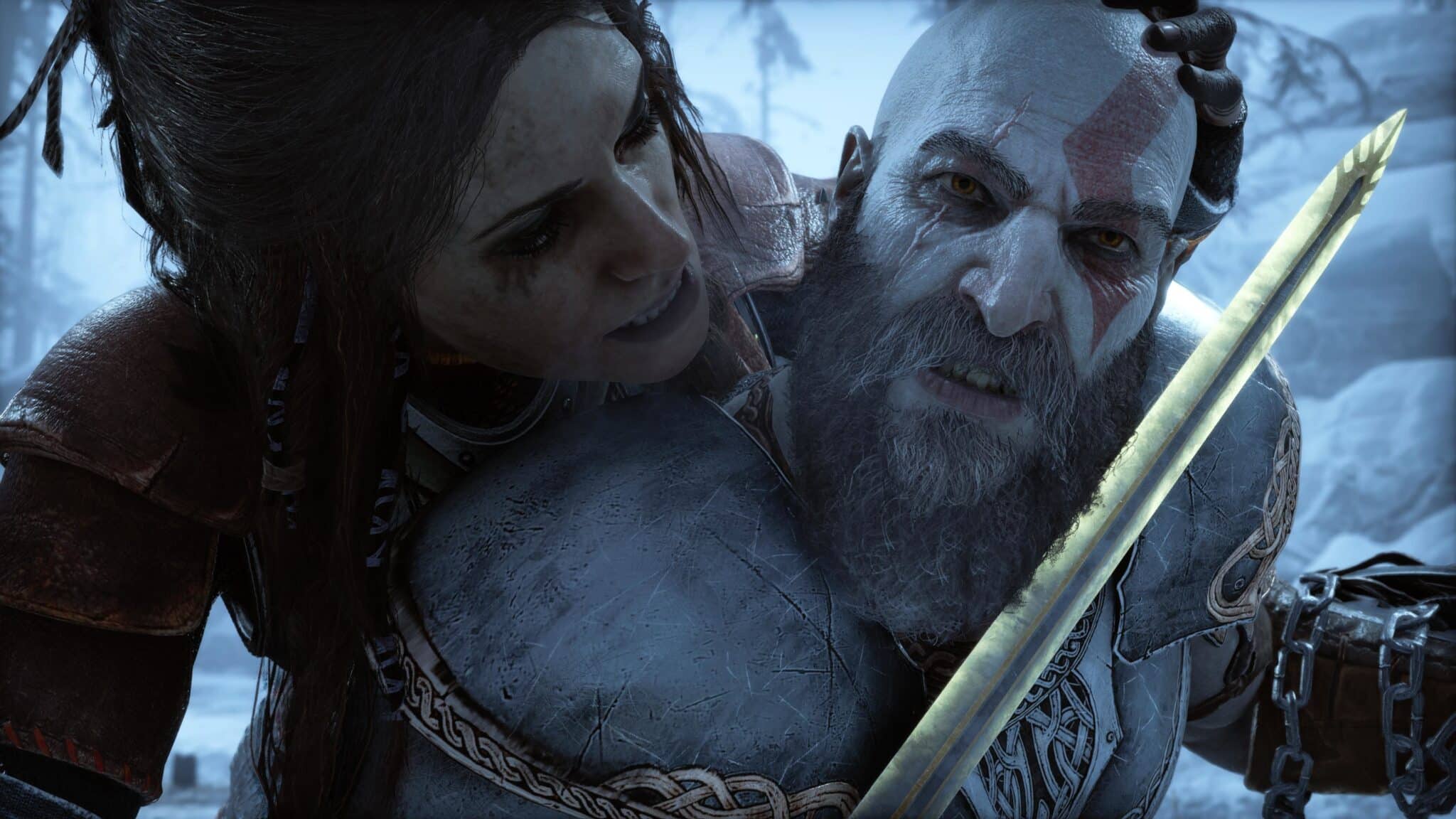
And since the apple doesn’t fall far from the tree, Atreus’ fate remains the one that interests us the most and will decide everything. God of War Ragnarok demonstrates a pleasing amount of courage for a mainstream video game, if not the courage like The Last of Us 2 to completely push its premise to the pain barrier and beyond.
If you only strictly follow the main story, you will need at least 20 hours to reach the grand finale. Like its predecessor, however, God of War Ragnarok delivers enough optional (end-game) challenges to easily spend twice as much time with Kratos without any of it feeling superfluous or unnecessarily stretched.
God of War Ragnarok could have been the standout title of 2022 in this drought with much less alongside Elden Ring, but with this rich buffet it’ll be remembered fondly in the hopefully much better gaming years to come. We put the wet sweaty controller aside, stare at the credits and can’t quite put into words what we’ve just experienced. “Video game” doesn’t quite cover it, “fucking awesome masterpiece” does.
Editor’s verdict
I’ll be honest: I was mega-skeptical about God of War Ragnarok. Sure, the first part was an emotional firework, a massive monster slasher and a beautiful graphic wonder. But four, almost five years later, the romantic transfiguration has waned somewhat. Instead, the weaknesses stood out more clearly, despite all the strengths. Well, that was 2018, okay, but it would have been fatal to serve it up to us exactly like that again in 2022.
That’s exactly what I feared with the last trailer. And that Santa Monica would answer “Yes” to the question “How much mythology do we want in it?”. After all, God of War was great, a winning formula has been found, so why dare to do something new now? It just stands to reason to get comfortable and play it safe.
As much as we pray to the gaming gods, we’re not entitled to good games, we have to be lucky – and we’ve rarely had that this year. Despite all my fears, however, I was not disappointed. More than that, God of War Ragnarok surprised me grumpy and ravenous gamer several times. Forgive me for doubting! The saviour of this year! Someone was creative and clever, someone took the time to create beautiful worlds, someone thought, “Now what else can we put in that people could really have fun with?”
My 25 hours of play were a brutal and wonderful road trip through Norse mythology. With some of this year’s games I had to turn a blind eye or two to be able to call them masterpieces. With this one, instead, I was allowed to open my eyes, allowed to expect without being disappointed. The end is a debate for later. But up to this point: Thank you!
